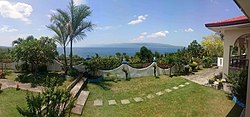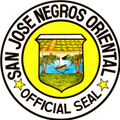This article needs additional citations for verification .(March 2013) |
San Jose | |
|---|---|
| Municipality of San Jose | |
 Overlooking view of Tañon Strait from San Jose | |
| Nickname: The Regional Pineapple Capital | |
 Map of Negros Oriental with San Jose highlighted | |
Location within the Philippines | |
| Coordinates: 9°25′N123°14′E / 9.42°N 123.23°E | |
| Country | Philippines |
| Region | Negros Island Region |
| Province | Negros Oriental |
| District | 2nd district |
| Founded | 1954 |
| Barangays | 14 (see Barangays) |
| Government | |
| • Type | Sangguniang Bayan |
| • Mayor | Mel Nick S. Logronio (NP) |
| • Vice Mayor | Quirino R. Renacia (NP) |
| • Representative | Ma. Isabel L. Sagarbarria (Lakas) |
| • Municipal Council | Members |
| • Electorate | 16,693 voters (2025) |
| Area | |
• Total | 54.46 km2 (21.03 sq mi) |
| Elevation | 99 m (325 ft) |
| Highest elevation | 728 m (2,388 ft) |
| Lowest elevation | 0 m (0 ft) |
| Population (2024 census) [3] | |
• Total | 22,870 |
| • Density | 419.9/km2 (1,088/sq mi) |
| • Households | 5,389 |
| Economy | |
| • Income class | 4th municipal income class |
| • Poverty incidence | 20.37 |
| • Revenue | ₱ 139.6 million (2022) |
| • Assets | ₱ 301.9 million (2022) |
| • Expenditure | ₱ 142.5 million (2022) |
| • Liabilities | ₱ 90.72 million (2022) |
| Service provider | |
| • Electricity | Negros Oriental 2 Electric Cooperative (NORECO 2) |
| Time zone | UTC+8 (PST) |
| ZIP code | 6202 |
| PSGC | |
| IDD : area code | +63 (0)35 |
| Native languages | Cebuano Tagalog |
San Jose (Cebuano : Lungsod sa San Jose; Tagalog : Bayan ng San Jose), officially the Municipality of San Jose, is a municipality in the province of Negros Oriental, Philippines. According to the 2024 census, it has a population of 22,870 people. [5] It is the least populous town in Negros Oriental.




